Art print | Gloria - Thomas Wilmer Dewing


View from behind

Frame (optional)
Gloria Art print - Thomas Wilmer Dewing – Captivating introduction
The painting "Gloria" by Thomas Wilmer Dewing is a work that embodies the quintessence of early 20th-century American art. In this canvas, the viewer is transported to a universe where beauty and serenity meet. Dewing, known for his delicate compositions and portraits imbued with mystery, invites us to contemplate feminine grace through a subtle and poetic representation. The central figure, draped in flowing fabrics, appears both dreamy and conscious, capturing the essence of a time when art was an exploration of emotions and sensations. This art print of "Gloria" allows us to rediscover this iconic work, while placing it within our living spaces, where it can continue to inspire and move.
Style and uniqueness of the work
Dewing's style is distinguished by his refined use of color and light. In "Gloria," soft pastel shades blend harmoniously, creating an ethereal atmosphere. The meticulous details of the clothing and hair of the female figure testify to a concern for realism, while the blurred backgrounds add an almost dreamlike dimension to the composition. This approach, characteristic of the Pre-Raphaelite movement, highlights the timeless beauty of feminine subjects. Dewing manages to capture not only the external appearance but also the inner state of his protagonist, making the work deeply emotional. The juxtaposition between the softness of forms and the depth of feelings evoked makes "Gloria" a work of great singularity, both classic and innovative.
The artist and his influence
Thomas Wilmer Dewing, born in 1851, was one of the pioneers of American Impressionism. His career was marked by an incessant quest for beauty and harmony, influenced by European masters while developing a unique style. Dewing succeeded in establishing himself in the art world through his portraits and intimate scenes, often populated by female figures. His work had a significant impact on his contemporaries and helped shape the perception of beauty in the

Matte finish

View from behind

Frame (optional)
Gloria Art print - Thomas Wilmer Dewing – Captivating introduction
The painting "Gloria" by Thomas Wilmer Dewing is a work that embodies the quintessence of early 20th-century American art. In this canvas, the viewer is transported to a universe where beauty and serenity meet. Dewing, known for his delicate compositions and portraits imbued with mystery, invites us to contemplate feminine grace through a subtle and poetic representation. The central figure, draped in flowing fabrics, appears both dreamy and conscious, capturing the essence of a time when art was an exploration of emotions and sensations. This art print of "Gloria" allows us to rediscover this iconic work, while placing it within our living spaces, where it can continue to inspire and move.
Style and uniqueness of the work
Dewing's style is distinguished by his refined use of color and light. In "Gloria," soft pastel shades blend harmoniously, creating an ethereal atmosphere. The meticulous details of the clothing and hair of the female figure testify to a concern for realism, while the blurred backgrounds add an almost dreamlike dimension to the composition. This approach, characteristic of the Pre-Raphaelite movement, highlights the timeless beauty of feminine subjects. Dewing manages to capture not only the external appearance but also the inner state of his protagonist, making the work deeply emotional. The juxtaposition between the softness of forms and the depth of feelings evoked makes "Gloria" a work of great singularity, both classic and innovative.
The artist and his influence
Thomas Wilmer Dewing, born in 1851, was one of the pioneers of American Impressionism. His career was marked by an incessant quest for beauty and harmony, influenced by European masters while developing a unique style. Dewing succeeded in establishing himself in the art world through his portraits and intimate scenes, often populated by female figures. His work had a significant impact on his contemporaries and helped shape the perception of beauty in the






